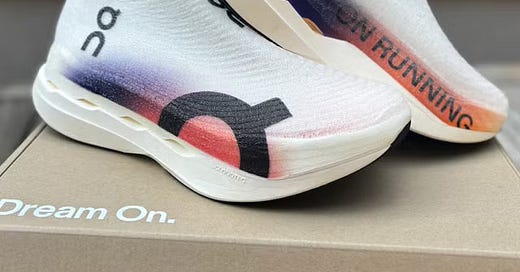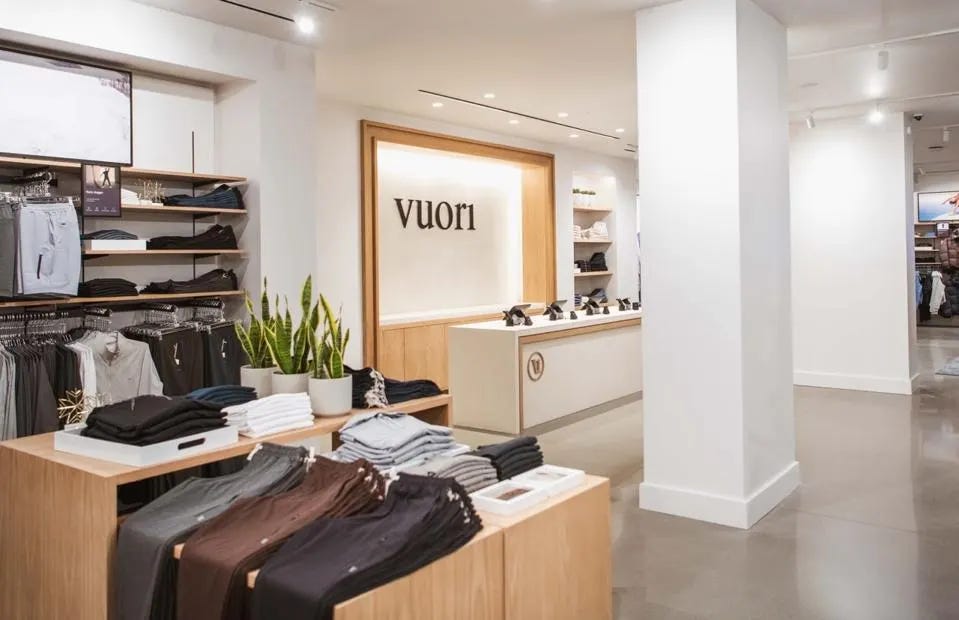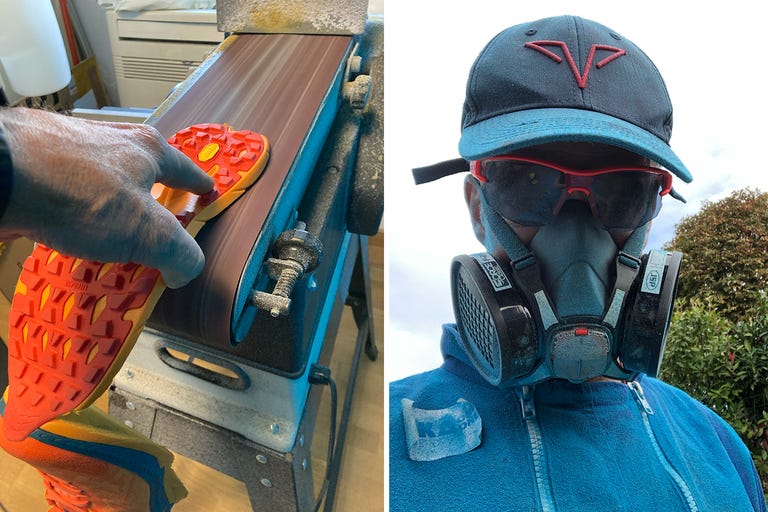Why Are Sports Brands Suddenly Focusing on Performance?
... and interesting sports and outdoor articles worth reading
There have been a lot of interesting articles diving into the business of the sports and outdoor industry recently. This week I’m sharing those that stand out, with a few thoughts on each.
But first, there’s a topic that has been top of mind for me over the last few weeks:
WHY ARE SPORTS BRANDS SUDDENLY FOCUSING ON PERFORMANCE?
Using authentic innovation to drive growth
Photo: Ali Ball
Let’s start with a little background. Over the last decade, performance brands like Nike shifted their focus from performance to athleisure due to the size and growth potential of that market. At the same time, new brands like Vuori emerged, primarily targeting the athleisure segment, also trying ride growth in the market.
Energy for athleisure products was largely driven by style — retro styles, collaborations and fit. Fast forward to today, these trends are tiring with consumers, and they are craving something new. Enter innovation.
To deliver real newness, brands are now pivoting back to performance. Why? Because when brands focus on athleisure, they end up chasing trends. But, when brands focus on innovation, they set trends. The challenge is that you can’t really innovate products for style. But, you can innovate for consumer performance needs and then make them a style trend (e.g. Polo shirts).
Recently, brands have dialed up their focus on performance through both products and marketing. Recent examples include:
Nike: Winning Isn’t for Everyone campaign
Lululemon: Womens Ultramarathon FURTHER
On: Lightspray technology
And the list goes on…
By anchoring themselves in performance, brands can stop chasing fleeting style trends and start setting them. And if you lead the trend, you lead in revenue growth.
So what should brands do (even athleisure brands)?
First, brands should identify the friction points consumers are experiencing during during activity, given the products they are using. If this tells you the “what,” the second step is to identify the “why.” Answer the question, “Why is this a friction for the consumer?" and identify the consumer’s deeper need. Third, solve that deeper need for the consumer. In other words, answer the “how.” Don’t be afraid of the “crazy” ideas; they are often times the most innovative.
An example in my household is sneakers for my six-year-old son. The friction point he had was putting on his own shoes by himself, quickly. Why? Not all kids have the dexterity to tie their own laces quickly at the age of six, but they want to express their independence in getting ready by themselves. So, how can a brand make putting on footwear easier for kids in order to provide them a feeling of greater independence? The answer: the Nike Dynamo 2.
The next few months will be telling. Expect some brands to launch truly innovative products, while others may just use the term “innovation” without real substance.
In the end, true innovation is a win-win for brands and consumers.
Notable reads and thoughts:
LESSONS FROM THE DECLINE OF BIG SURF
The End of Big Surf: The surf industry returns to the garage. (Surfing World)
Photo: Thomas Robinson
I may be late to reading this piece, but I’m guessing I may not be the only one. The article highlights the decline of Big Surf brands over the past decade and the rise of small, authentic surf brands. While it offers a great insider’s look at the surf industry, it also serves as a cautionary tale for large companies like Nike, as Lee Glandorf points out in her recent post.
Big sports brands, like Nike, have become giants. But with that growth comes the challenge of trying to be everything to everyone—and in doing so, they risk losing the niche authenticity that makes their sports meaningful.
“There’s a natural size for a surf company, above which it becomes less surf and more company” states Doherty.
Have Nike, and similar brands, become more about profit than sport? Have they lost their authenticity and connection? Is this why smaller, niche brands are gaining traction? For me, the answer seems clear: consumers are craving a return to authentic connection to sport.
The good news is that the article outlines how brands can rebuild their authenticity. Doherty explains “A sustainable business is great—economically and environmentally—but it also needs to be culturally sustainable as well. It needs to give something back to surfing, in some small way. Surfers won’t let you sell it out.”
In other words, athletes won’t let any company sell out their sport. If brands aren’t contributing to the culture, athletes will turn to those that are.
So, how can big brands be authentic? By listening to the consumer, creating products that make athletes better, and promoting—not owning—the culture of the sport.
—
CONSUMER RESEARCH IS EVERYONE'S ROLE
Vuori’s New CMO Just Won’t Stop Talking To Customers (Forbes)
Photo: Vuori
Consumer research is becoming increasingly important for brands in the sports and outdoor industry. Karen Riley-Grant, CMO of Vuori, perfectly highlights this in the recent Forbes article.
“Our job as marketers is to obsess over the consumer,” Riley-Grant says.
But it’s not enough to just listen to consumers—brands need to take action. In my experience, this is often the most challenging aspect of insight integration. What I appreciate about Karen’s approach is that insights are driven not just by the research team, but by the business itself. This leads to greater adoption and real change.
“There’s so much work to do. It feels like a luxury to say, ‘Hey, let’s spend a day walking our stores.’ But by not taking the time to listen to social commentary and hear from store staff, we miss what the consumer really thinks,” she states.
Consumer research may take time, but it doesn’t have to be overwhelming. This is why I created the Insight Accelerator Consumer Research Trainings. I’ve seen firsthand the benefit of also equipping PLMs, marketers, designers, and more with the confidence and skills to conduct their own research. It’s a skill that anyone in a role that engages with consumers should have in their toolkit — to limit this skillset to the research team, brands are missing an opportunity deeper, richer insights.
For larger, more complex research projects, Karen puts it perfectly:
“…But the next level of insights may indeed require an investment.”
For projects like segmentation studies or pricing analysis, having specialized support is essential. Karen has built a research team to handle this, but if you don’t have the budget or capacity to create a full department, consider partnering with vendors or consultants. They can provide the expertise you need on a case-by-case basis. If you need advice or recommendations, feel free to reach out—I'd be happy to help.
—
THE SKI RACE TECHNICIAN OF RUNNING SHOES
How Hoka’s Trail Running Shoe Whisperer Tweaks Models for Its Elite Athletes (Run)
Photo: Chirstophe Aubonnet
Talk about listening to athletes/consumers! This article highlights how Hoka co-founder, Christophe Aubonnet, customizes footwear for elite runners—often straight from the back of his car. It’s a fantastic example of not only listening to athletes but also anticipating their unique needs. (Does this remind anyone else of how Bill Bowerman started from a place of athlete-focused innovation?)
“Aubonnet likens himself to a ski race technician who tunes ski edges to match the conditions of a race course. ‘It’s a racing service,’ he says. ‘It’s tuning the product to make them dedicated to specific athletes, to make [the shoes] really their own.’”
This hands-on approach shows how brands can elevate their products by truly understanding and responding to individual athletes’ needs.
—
WHAT IS THE DEAL WITH TENNISCORE?
What's the Deal with Tenniscore?: Trend math, U.S. Open fit checks and more...
It’s not just shorts making a comeback in women’s fashion—tennis skirts are everywhere too. Lee Glandorf breaks down the origins of this trend in her latest article, diving into how Tenniscore took over. She also touches on the on-court styles from the U.S. Open. Definitely worth a read!







